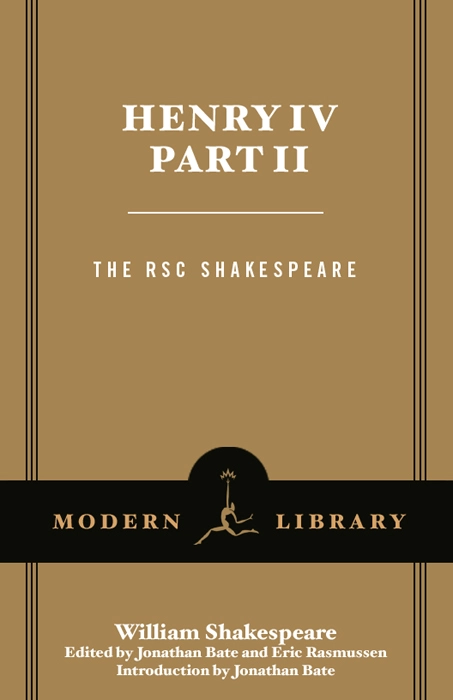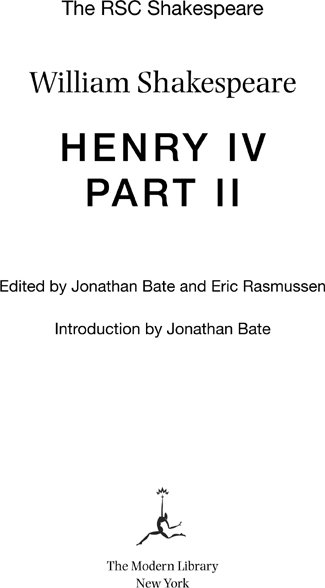Henry IV, Part 2

The RSC Shakespeare
Edited by Jonathan Bate and Eric Rasmussen
Chief Associate Editors: Héloïse Sénéchal and Jan Sewell
Associate Editors: Trey Jansen, Eleanor Lowe, Lucy Munro,
Dee Anna Phares
Henry IV Part II
Textual editing: Eric Rasmussen
Introduction and Shakespeare’s Career in the Theater: Jonathan Bate
Commentary: Jan Sewell and Héloïse Sénéchal
Scene-by-Scene Analysis: Esme Miskimmin
In Performance: Karin Brown (RSC stagings), Jan Sewell (overview)
The Actor’s Voice and the Director’s Cut
(interviews by Jonathan Bate and Kevin Wright): Michael Pennington,
Adrian Noble, Michael Boyd
Editorial Advisory Board
Gregory Doran, Chief Associate Director,
Royal Shakespeare Company
Jim Davis, Professor of Theatre Studies, University of Warwick, UK
Charles Edelman, Senior Lecturer, Edith Cowan University,
Western Australia
Lukas Erne, Professor of Modern English Literature,
Université de Genève, Switzerland
Akiko Kusunoki, Tokyo Woman’s Christian University, Japan
Jacqui O’Hanlon, Director of Education, Royal Shakespeare Company
Ron Rosenbaum, author and journalist, New York, USA
James Shapiro, Professor of English and Comparative Literature,
Columbia University, USA
Tiffany Stern, Professor of English, University of Oxford, UK

CONTENTS
Introduction
Tragical-Comical-Historical-Pastoral
“The Prince but Studies His Companions”?
The Language of Time
The Reformation of England?
About the Text
Key Facts
The Second Part of Henry the Fourth, Containing His Death and the Coronation of King Henry the Fifth
Synopsis of Henry IV Part I
Textual Notes
Quarto Passages That Do Not Appear in the Folio
Oaths from the Quarto
Scene-by-Scene Analysis
Henry IV in Performance: The RSC and Beyond
Four Centuries of Henry IV: An Overview
At the RSC
The Actor’s Voice and the Director’s Cut: Interviews with Michael Pennington, Adrian Noble, and Michael Boyd
Shakespeare’s Career in the Theater
Beginnings
Playhouses
The Ensemble at Work
The King’s Man
Shakespeare’s Works: A Chronology
Kings and Queens of England: From the History Plays to Shakespeare’s Lifetime
The History Behind the Histories: A Chronology
Further Reading and Viewing
References
Acknowledgments and Picture Credits
INTRODUCTION*
TRAGICAL-COMICAL-HISTORICAL-PASTORAL
Shakespeare’s art of mingling comedy, history, and tragedy reached its peak in the two parts of Henry IV. As history, the plays paint a panorama of England, embracing a wider social range than any previous historical drama as the action moves from court to tavern, council chamber to battlefield, city to country, Archbishop and Lord Chief Justice to whore and thief. As comedy, they tell the story of a prodigal son’s journey from youth to maturity and an old rogue’s art of surviving by means of jokes, tall tales, and the art of being not only witty in himself, but the cause that wit is in other men. As tragedy, they reveal the slow decline of a king who cannot escape his past, the precipitate demise of an impetuous young warrior who embodies both the glory and the futility of military heroism, and the heartbreaking dismissal of a substitute father who has loved a prince with a warmth of which his true father is incapable.
The action of Part I had begun some time after the events that ended Shakespeare’s earlier play, Richard II. Henry Bullingbrook has usurped the throne of King Richard, who has been murdered. But now the rebels who helped Henry to the throne have turned against him. Whereas Richard II conformed to the traditional structure of tragedy—the story of the fall of a powerful man—the Henry IV plays adopt a wider perspective. Richard II had been written entirely in verse, the medium of royal and aristocratic characters, whereas long stretches of the Henry IV plays are in prose, the medium of the common people. The scenes with Justice Shallow in his Gloucestershire orchard are the closest that Shakespeare ever came to a stage representation of the rural England of his own early life in Stratford-upon-Avon.
Though the language of King Henry IV as he approaches death is deeply tragic in tone, the deep structure of the two parts of Henry IV is that not of tragedy but of pastoral comedy. They were written around the same time as Much Ado About Nothing and As You Like It, when Shakespeare’s comic muse was at its zenith. They are his most enjoyable history plays because they are his funniest—and in the figure of Sir John Falstaff they introduce his greatest comic character—but they also share with the comedies a technique of counterpointing the intrigue of court and power politics against what has been called the “green” or “festive” world.
The traditional comic pattern turns on the successful effort of a young man to outwit an opponent and possess the girl of his choice. The girl’s father, or some other authority figure of the older generation, resists the match, but is outflanked, often thanks to an ingenious scheme devised by a clever servant, perhaps involving disguise or flight (or both). The union of the lovers brings a renewed sense of social integration, expressed by some kind of festival at the climax of the play—a marriage, a dance, or a feast. All right-thinking people come over to the side of the lovers, but in Shakespearean comedy there is usually a party pooper, a figure who refuses to be assimilated into the harmony—Malvolio in Twelfth Night, Don John in Much Ado About Nothing, Jaques in As You Like It, Shylock in The Merchant of Venice. The key to the two parts of Henry IV is that they take the comic structure and apply it to Prince Harry—with the difference that instead of his courtship (which ends up being tacked on very briefly at the end of Henry V), the action turns on his maturation from wild youth to exemplary warrior prince and statesman. And, in a brilliant reversal, the figure who is isolated at the end is not the party pooper but the very embodiment of the festive spirit: Sir John Falstaff. Comedy is thus placed in opposition to the march of history. Beside the sense of waste and exhaustion in the figure of the dying king, the necessity to reject Falstaff in the name of historical destiny and social order is why the final resolution is tinged with the feeling of tragedy.
The distinctive feature of pastoral comedy is that the action develops by means of a shift of location from the everyday world of work, business, politics, patriarchy, and power to a “green” or “festive” place of play, leisure, anarchy, feminine influence, and love—the wood in A Midsummer Night’s Dream, Belmont in The Merchant of Venice, the Forest of Arden in As You Like It, rural Bohemia in The Winter’s Tale. After the comic resolution is achieved, there has to be a return to the normative world, but recreative change has been effected by the values of the festive world. In Henry IV Part I, a tavern in Eastcheap has played the part of the festive world. In Part II, there is a reprise of that setting, but also a journey into a rural green world. As in the comedies, the shuttle between contrasting worlds and contradictory value systems creates the dialectic of the drama. But because of the calling of the prince to power, there can be no reconciliation between the value systems. As Prince Hal has announced in his first soliloquy back in Part I, his time of “playing holidays” and “loose behaviour” will be but an interlude before he takes upon himself the mantle of historical duty.
“THE PRINCE BUT STUDIES HIS COMPANIONS”?
Henry IV believes that one of the failings of his predecessor Richard II had been to seek to make himself popular, thus eroding the necessary distance that creates awe and gives mystique to the monarchy. But King Henry’s own distance from public life—he is nearly always seen surrounded by an inner circle of courtiers or closeted alone in his chamber—causes power to ebb from him. His son, by contrast, comes to know the common people, developing a rapport that will enable him to inspire and lead his army in Henry V. The point is made through the very linguistic medium of the drama: all Shakespeare’s other English kings speak entirely in verse, whereas Prince Hal has command of a flexible prose voice, with which he reduces himself to the level of his people, an Eastcheap trick that he repeats when he goes in disguise among his men on the night before the battle of Agincourt.
The king’s trustiest follower, the Earl of Warwick, reassures him that Prince Hal’s intention has always been to throw off his companions when the time is ripe:
The prince but studies his companions
Like a strange tongue, wherein, to gain the language,
’Tis needful that the most immodest word
Be looked upon and learned, which once attained,
Your highness knows, comes to no further use
But to be known and hated. So, like gross terms,
The prince will, in the perfectness of time,
Cast off his followers, and their memory
Shall as a pattern or a measure live,
By which his grace must mete the lives of others,
Turning past evils to advantages.
According to this account, the prince works according to the principle articulated by the cunning politician Ulysses in Troilus and Cressida: a man “Cannot make boast to have that which he hath, / Nor feels not what he owes, but by reflection, / As when his virtues shining upon others / Heat them and they retort that heat again / To the first giver.” That is to say, we can only make value judgments through a process of comparison. In Part I, by temporarily ceding glory to Henry Hotspur, Prince Henry shows himself all the more glorious when he eventually triumphs over his adversary. His whole strategy is revealed in the imagery of his first soliloquy in Part I, “I know you all, and will awhile uphold / The unyoked humour of your idleness.
1 comment